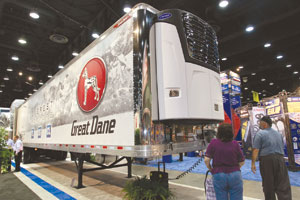EPA Proposal on Insulation Raises Reefer-Sector Concern

This story appears in the May 25 print edition of Transport Topics.
A final U.S. Environmental Protection Agency regulation expected this summer has generated significant concerns from suppliers to the refrigerated trucking sector, with the main worry being that a January 2017 rollout date is too soon.
The Protection of Stratospheric Ozone rule was proposed last August but generally escaped the attention of trucking. The proposal is mainly aimed at chemical companies and producers of refrigeration equipment, and it seeks to discontinue chemicals that are very strong greenhouse gases.
The proposal never uses the word “trailer” and mentions “trucks” only in connection with light-duty vehicles. However, it still could have great importance for operators of refrigerated trailers.
“While the rule did not explicitly reference impacts on tractors or trailers in the trucking sector, this rule will most definitely have impacts on the industry, both with respect to insulation in the trailers and the refrigerants used by the refrigerated sector,” said Glen Kedzie, energy and environmental affairs counsel for American Trucking Associations.
Kedzie said the timing for implementation is the major issue, and even the California Air Resources Board agreed on that point.
CARB Executive Officer Richard Corey filed comments with EPA, commending the federal agency’s “leadership on reducing these potent greenhouse gases with global warming potential hundreds to thousands of times greater than that of carbon dioxide.”
Corey went even further than EPA, offering several suggestions on how the regulation could be stronger. He did, however, offer some caution on HFC-245fa, a hydrofluorocarbon used as a foam-blowing agent, an important part of reefer trailer insulation.
“Industry indicates that several years may be necessary to perfect formulations so that low-global-warming-potential spray foams perform as well in consistent application thickness and energy efficiency as those currently using . . . HFC-245fa foam-expansion agents,” Corey said for CARB.
He recommended that a date for prohibiting use of 245fa should remain in the rule to “provide certainty for industry to continue to invest in further development and testing of low-GWP alternates,” but he did not say it had to be January 2017.
Reefer trailers have interior and exterior panels, and in between is a layer of insulation. The material is pumped into the gap between panels as foam that expands greatly — up to 20 times the volume — and then solidifies.
After that happens, said Jeffrey Bennett, vice president of engineering and product development for Utility Trailer Manufacturing Co., the insulation helps keep products cold and improves structural stability for the van. Utility, based in City of Industry, California, is one of North America’s largest reefer trailer manufacturers.
By providing two important functions at once, insulation and stability, Bennett said, a manufacturer gets a bonus as if “one plus one equals three.”
Bennett said cyclopentane, somewhat similar to benzene, is a much-discussed replacement blowing agent. Not only is cyclopentane flammable, which he said is not desirable, but the substance does not offer the same structural benefits as 245fa, and it “deteriorates quickly.”
EPA has not given the industry enough time for testing and development, Bennett said. The industry changed foams in 2008, he said, but started working on change in 2005.
“We made 10,000 trailers to test then,” Bennett said of the 2005-2008 change.
If the final rule has the same January 2017 deadline as the proposed version, Utility would be about 1½ years from the switch. “Not one trailer has been built; we’re not even past the first step,” Bennett said.
Charles Fetz, vice president of design and development for Great Dane Trailers, said the rule came in “under the radar,” and the 2017 timing is a problem. Chicago-based Great Dane makes dry and refrigerated vans, and Fetz said cyclopentane might work.
He said chemicals called HFOs, or hydrofluoro-olefins, are also an option, but not enough preparation has been done.
“We’re now in the process of trying to qualify a replacement, HFOs or pentane. HFOs are well beyond experimental, but they’re still in their infancy,” Fetz said, adding that when a chemical change is agreed upon, a manufacturer faces two years of engineering changes before production is running smoothly at high volume.
Dow Chemical Co., based in Midland, Michigan, is a major manufacturer of the sort of foam-blowing agents used by refrigerated trailer makers. The company also offered a warning on the issue of timing for a 245fa replacement.
“More time is needed to move to alternatives, allowing these specific end-use markets time to identify and convert,” Dow said.
“Presently, there are no widely available candidate blowing agents that meet established performance criteria for broad use . . . within the United States. Several of the EPA-listed substitutes are hydrocarbon-based and, therefore, flammable,” the chemical maker said, adding that 2020 would be preferable to 2017.


